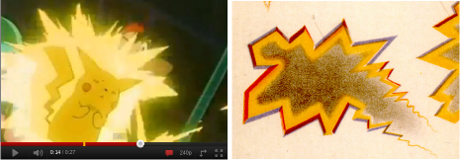Culture of Optimal Sensory Overload
Visual triggers of epilepsy and migraine are light stimuli optimally tuned to the neural wiring of the cerebral cortex — and they are by no means limited to flickering video games anymore.
High-contrast stripes and zigzag patterns can trigger migraines. This isn’t just anecdotal—it aligns with what we know about how neurons are wired in the cerebral cortex, or more precisely, the functional architecture of the visual cortex. That architecture consists of specialized, periodically arranged subunits that respond resonantly to matching spatiotemporal patterns in the visual field. At least, that’s the prevailing hypothesis—one that aligns well with data from psychophysical experiments and mathematical modeling [1].
Visual triggers are not unique to migraine. Epilepsy, too, can be provoked by visual stimuli. Photosensitive epilepsy is, in fact, one of the more recognized subtypes. While this post doesn’t go into the detailed differences between migraine and epilepsy triggers, a general rule holds: migraine is commonly provoked by stripe and zigzag patterns, whereas epilepsy is often associated with colored light flashes—especially rapid, intense shifts in red. These kinds of stimuli have been shown to evoke epileptiform potentials in EEG recordings [2,3]. In the previous post, I explained how these spatiotemporal patterns relate to migraine.
Spatiotemporal patterns?
A spatial pattern is simply an image. A spatiotemporal pattern, then, is a sequence of images—a short film, in essence. Many technical terms sound more complex than they are. Still, saying “a film can trigger a seizure” would be misleading. These visual triggers are not just any moving image—they are highly specific patterns, as if created by a perfect stencil.
Then again, the metaphor of a film isn’t entirely off. Christian Reinboth (from the blog Frischer Wind) recently pointed out that viewers reportedly experienced seizures during a particularly intense scene—the birth scene—in the Twilight movie Breaking Dawn. That moment combined strobe-like flashes with saturated color, especially red.

“I think within the confines of a PG-13 rating, I think we’ve got something that’s pretty powerful.” —Bill Condon, Director
I haven’t seen the scene myself, but by all accounts, the director succeeded in making it as graphic as possible. The PG-13 rating (roughly equivalent to Germany’s FSK 12) suggests parental guidance—but of course, adults also suffer from epilepsy and migraine. And if you check the comment sections in The Guardian or HuffPost, you’ll find plenty of viewers mentioning migraines, too. This overlap makes sense: migraine and epilepsy share elements of pathophysiology, and visual triggers are rarely exclusive to one condition.
The most notorious example of an epilepsy-inducing sequence comes from the 1997 Pokémon episode Dennō Senshi Porygon (“Cyber Soldier Porygon”). After its single airing, more than 600 children were hospitalized—many of them for their first-ever seizure. The episode has since been banned.

Right: A 19th-century drawing of a visual migraine aura. The resemblance is striking.
Are today’s known visual triggers—whether for migraine or epilepsy—the result of cultural fine-tuning? Have certain light patterns been replicated, stylized, and optimized for maximum effect on our brain’s modular architecture? It’s not far-fetched. Directors and designers often seek visceral reactions—the ultimate adrenaline kick. Their lightning-fast image sequences have become almost stereotypical. Once crude in comic books, these patterns are now computer-animated—and everywhere.
Even family-friendly films like Toy Story 3 or visual spectacles like Avatar have raised concerns about seizure risk. But it’s not the 3D effects per se [5]. It’s the rapid flashing, flickering, and zigzagging projected on screens—big and small. Today, most of us are never more than 30 cm away from a screen.
So it’s not surprising that these visual patterns—ever faster, ever brighter—are chasing our attention while converging, perhaps unknowingly, on the very configurations that overstimulate the brain. They have become stealthy triggers for migraine and epilepsy.
You could describe this phenomenon as sensory overload, shaped by a Dawkinsian principle: visual patterns are copied, varied, and selected for one thing—their impact. The flashier, the better. And what’s flashier than a light pattern labeled epileptogenic? That’s the upper limit of neural provocation. Perhaps I’m overstating. I’m not accusing anyone of bad intent, nor am I predicting cultural decline.
But it’s worth remembering: every era and every culture has had its own visual migraine and epilepsy triggers. We have Pokémon. We have vampire birth scenes. And, yes, we have hip-hop. But more on that next time.
Literatur
[1] Dahlem, MA, et al.: Does the migraine aura reflect cortical organization? European Journal of Neuroscience 12.2 (2000): 767-770.
[2] Shozo, T: Chronomatic sensitive epilepsy: a variant of photosensitive epilepsy, Annals of Neurology, (1999) 45,790-793
[3] Fisher RS, Harding G, Erba G, Barkley GL, Wilkins A; Epilepsy Foundation of America Working Group: Photic- and pattern-induced seizures: a review for the Epilepsy Foundation of America Working Group. Epilepsia. (2005) 46,1426-1441.
[4] Prasad M, Arora M, Abu-Arafeh I, Harding G.: 3D movies and risk of seizures in patients with photosensitive epilepsy. Seizure. (2011) im Druck. [5] Kager, H. , Wadman, W. J. and Somjen, G. G.: Simulated seizures and spreading depression in a neuron model incorporating interstitial space and ion concentrations, (2000) J. Neurophysiol. 84, 495.